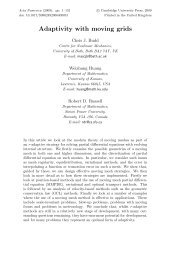Signature of phonon drag thermopower in periodically modulated ...
Signature of phonon drag thermopower in periodically modulated ...
Signature of phonon drag thermopower in periodically modulated ...
You also want an ePaper? Increase the reach of your titles
YUMPU automatically turns print PDFs into web optimized ePapers that Google loves.
ALAIN NOGARET PHYSICAL REVIEW B 66, 125302 2002<br />
FIG. 2. Top panel: theoretical full l<strong>in</strong>e and experimental<br />
dashed l<strong>in</strong>e magnetoresistance <strong>of</strong> a lateral superlattice with period<br />
a500 nm. The Drude resistance 460 was calculated from the<br />
values <strong>of</strong> and n s and a hall bar aspect ratio <strong>of</strong> 20; no fitt<strong>in</strong>g<br />
parameter was used <strong>in</strong> the theoretical curve. Bottom panel: theoretical<br />
full l<strong>in</strong>e and experimental dashed l<strong>in</strong>e <strong>phonon</strong> <strong>drag</strong> <strong>thermopower</strong><br />
<strong>of</strong> the same lateral superlattice. The fitt<strong>in</strong>g parameters to<br />
the <strong>thermopower</strong> amplitude are a 0a 24020 (b 20).<br />
mial. It may be shown that c 4 , c 2 , and c 0 are even functions<br />
<strong>of</strong> B while c 3 and c 1 are odd functions <strong>of</strong> B. 26 It follows that<br />
real part the root, giv<strong>in</strong>g L xy , is antisymmetric with respect<br />
to B, as expected. The sign <strong>of</strong> the imag<strong>in</strong>ary part is chosen so<br />
that L xy and L yy have opposite sign when B0 and the same<br />
sign when B0.<br />
The theoretical <strong>thermopower</strong> S yy is plotted together with<br />
the experimental trace <strong>in</strong> the lower panel <strong>of</strong> Fig. 2 whereas<br />
the top panel compares the theoretical and experimental resistance.<br />
Compar<strong>in</strong>g the experimental peak positions <strong>in</strong> the<br />
top and bottom panels shows that the <strong>phonon</strong> <strong>drag</strong> <strong>thermopower</strong><br />
oscillates <strong>in</strong> phase with the resistance. One notes<br />
an anti-symmetric component <strong>in</strong> the experimental <strong>thermopower</strong>.<br />
Now consider<strong>in</strong>g the theoretical trace, commensurability<br />
<strong>thermopower</strong> oscillations arise because <strong>of</strong> the anisotropy<br />
<strong>in</strong> the scatter<strong>in</strong>g. The magnitude <strong>of</strong> these oscillations is<br />
proportional to a 2 : if the pr<strong>in</strong>cipal scatter<strong>in</strong>g axis is along<br />
the x axis (a 20) S yy oscillates <strong>in</strong> phase with R yy and out <strong>of</strong><br />
phase otherwise. The isotropic <strong>thermopower</strong> was evaluated<br />
as S 0220 V/K us<strong>in</strong>g a <strong>phonon</strong> mean free path equal to<br />
the etched sample length, 1 mm. The vertical fit to the<br />
experimental <strong>thermopower</strong> then gave a 2a 04020 <strong>in</strong>dicat<strong>in</strong>g<br />
that the magnitude <strong>of</strong> the oscillations is a relatively<br />
125302-6<br />
small fraction <strong>of</strong> S 0 . As shown <strong>in</strong> Fig. 2, the shape <strong>of</strong> the<br />
peaks <strong>in</strong> S yy is different, <strong>in</strong> particular the last oscillation is<br />
strongly attenuated <strong>in</strong> the theoretical trace. At vanish<strong>in</strong>g<br />
magnetic fields, both the <strong>thermopower</strong> and the resistance<br />
show a peak not observed <strong>in</strong> the experimental data. This is<br />
because our description does not account for the channel<strong>in</strong>g<br />
<strong>of</strong> open electron orbits that gives the positive magnetoresistance<br />
at low magnetic field. In order to <strong>in</strong>vestigate the sensitivity<br />
<strong>of</strong> <strong>phonon</strong> <strong>drag</strong> to the smoothness <strong>of</strong> the <strong>in</strong>terface, we<br />
have measured the <strong>thermopower</strong> after scrib<strong>in</strong>g the sample<br />
surface between the heater and the Hall bar. The presence <strong>of</strong><br />
the cut was found to dampen the amplitude <strong>of</strong> the oscillations<br />
very strongly. This outl<strong>in</strong>es the importance <strong>of</strong> hav<strong>in</strong>g a<br />
large mean free path for <strong>phonon</strong> modes travell<strong>in</strong>g parallel to<br />
the sample surface. 27<br />
In summary, commensurability oscillations <strong>in</strong> the <strong>phonon</strong><br />
<strong>drag</strong> <strong>thermopower</strong> <strong>of</strong> <strong>periodically</strong> <strong>modulated</strong> structures were<br />
shown to arise from the anisotropy <strong>of</strong> the electron-<strong>phonon</strong><br />
<strong>in</strong>teraction. The contribution <strong>of</strong> higher scatter<strong>in</strong>g harmonics<br />
(n2) was neglected because it decays as 1/n 2 . Their effect<br />
could nevertheless be calculated along similar l<strong>in</strong>es but this<br />
would only be useful if the spectrum <strong>of</strong> Fourier harmonics<br />
was known. In agreement with Ref. 17, our results show that<br />
both electron (0) and <strong>phonon</strong> anisotropy (a 2 ,b 20) are<br />
required for the <strong>phonon</strong> <strong>drag</strong> <strong>thermopower</strong> to exhibit a<br />
magnetic-field dependence.<br />
ACKNOWLEDGMENTS<br />
I wish to acknowledge useful discussions with Dr A. Pogosov.<br />
I also thank EPSRC and the Royal Society UK for<br />
support.<br />
APPENDIX A<br />
The coefficients <strong>of</strong> Eqs. 21 are<br />
r1 2 2<br />
12<br />
ql<br />
c 2 , nyA1<br />
i 2 2<br />
3<br />
ql c, A2<br />
r 1<br />
ql 2 cR R , A3<br />
i 1<br />
ql 2 cR R , A4<br />
r 2<br />
<br />
ql i 2 R r 2 R , A5<br />
i 2<br />
2<br />
ql c i 2 R r 2 R , A6
















